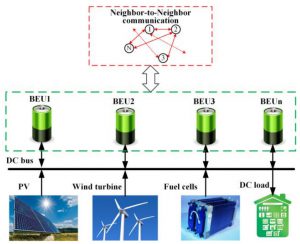Khanh Duc Hoang – School of Electrical Engineering, University of Ulsan, Ulsan, Korea. E-mail: duckhanhht13989@gmail.com
Hong-Hee Lee – School of Electrical Engineering, University of Ulsan, Ulsan, Korea. E-mail: hhlee@mail.ulsan.ac.kr
Abstract
This paper proposes a distributed control method to achieve state of charge (SoC) balancing among the distributed battery energy units (BEUs) in a DC microgrid based on accurate power sharing. The distributed control algorithm estimates the average SoC of all BEUs by means of consensus algorithm, and voltage regulation is determined by comparing the per unit power of BEU with the those of the neighbors. At the same time, the estimated average SoC and the voltage regulation are used to implement accurate power sharing according to the SoC levels of BEUs to achieve the SoC balancing regardless of the line resistance difference. Moreover, the control algorithm also restores the DC voltage level to the nominal value for stable operation. The effectiveness of the proposed method is proved by simulation.
Index Terms—DC microgrid, droop control, state of charge, consensus algorithm.
I. INTRODUCTION
The integration of DC renewable energy sources (RESs) and modern DC loads [e.g., photovoltaics (PVs), fuel cells and LEDs, etc.,] motivates the development of DC microgrid. Compared with the AC microgrid, the DC microgrid has been received more attention due to its higher efficiency for absence of intermediate AC power conversion stages, and it avoids the problems related to reactive power, harmonics and synchronization [1]–[3]. In DC microgrid, in order to guarantee the reliable operation, battery energy units (BEUs) are usually used to mitigate the power fluctuation caused by RESs such as wind power and PVs. Because BEUs are commonly distributed in microgrid system, their charging or discharging powers are different because of different line resistance [4]. As a result, their state of charge (SoC) levels become unbalanced, which can lead to over-charge or over-discharge of a certain BEU.
In order to solve this problem, a centralized control strategy was presented to provide SoC balancing among BEUs [5]. Nevertheless, the central controller may suffer from the risk of the single point failure, and it requires high computational burden which is not appropriate for the microgrid with many distributed BEUs [6]. In [7], [8], a droop scheme was proposed without using additional communication network, and the droop coefficient was modified to be inversely proportional to the exponential function of SoC (SoCn), where ‘n’ is identified as the convergence factor. However, it needs stability analysis and computing complicate exponential inequalities to select the suitable convergence factor.

Fig. 1. DC microgrid
In the previous studies, it is hard to achieve the accurate power sharing with the balanced SoC among BEUs due to the line resistance difference, which is inevitable in the distributed DC microgrid [9]. To solve the problem, a decentralized control strategy with virtual power rating concept was proposed to realize balanced SoC with accurate power sharing in DC microgrid [10]. Nonetheless, this control strategy requires a certain BEU to share its information with all other BEUs in the microgrid through full communication network, which raises the limitation to implement and the scalability in case of large number of BEUs [11].
In this paper, we propose a consensus-based distributed control to achieve SoC balancing among BEUs with the accurate power sharing in DC microgrid. In the proposed control method, the consensus algorithm is used to utilize the distributed secondary control at local controller of each BEU in order to estimate the average SoC of BEUs and the per unit output power comparation with those of the neighbors via neighbor-to-neighbor communication network. The estimated average SoC and the per unit power comparation are further used to regulate accurate power sharing according to SoC levels among BEUs to achieve the accurate SoC balancing regardless of the line resistance difference. Moreover, the voltage restoration is also considered to guarantee the suitable voltage level of the microgrid. The proposed method is analyzed theoretically, and its effectiveness is verified by simulation.





